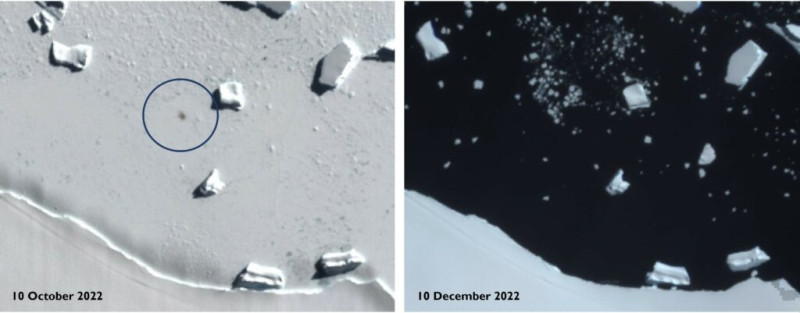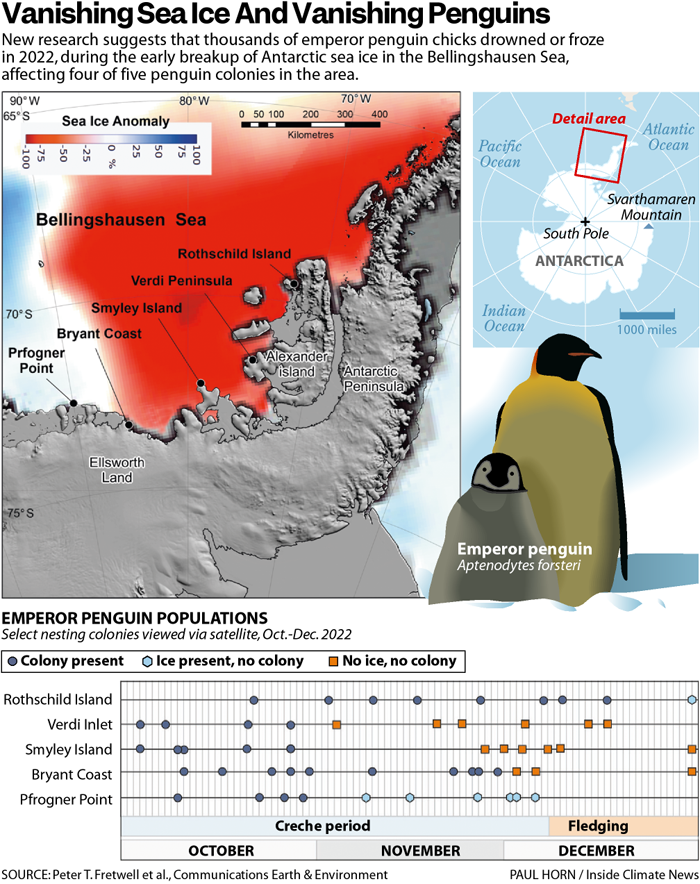Emperor Penguin Breeding Failure Linked With Antarctic Sea Ice Decline
As they have for millennia, thousands of emperor penguins arrived at their breeding grounds on the sea ice clinging to the rugged coast of the Antarctic Peninsula in May and June of 2022. The adults cradled their eggs until they hatched in late July and August, the middle of the long, dark Antarctic winter, and all seemed well.
But when the sea ice that’s normally frozen fast to the shore around the Bellingshausen Sea unexpectedly broke apart and drifted away from land in November, it spelled disaster for several recently discovered emperor penguin colonies in the region, where a new study, published today by researchers with the British Antarctic Survey, suggests there was a 100 percent reproduction failure at four of five breeding sites in the region last year, as thousands of penguin chicks drowned or froze when the ice disintegrated.
“Four out of the five colonies failed, which shows that this is quite an exceptional event,” said co-author Norm Ratcliffe, a BAS biologist. The penguins rely on the ice frozen to land remaining stable into late December and January, the Austral summer, because that’s when the chicks acquire waterproof plumage.

“Then they can leave the colony, they can swim away and become independent,” he said. “But if it breaks earlier than that, the chicks basically lose that platform. So they either fall into the sea and they drown. They might be able to scramble onto an ice floe or a nearby iceberg. But in that case, because their plumage is wet, they’ll probably freeze to death.”
Lead author Peter Fretwell, a long-time penguin researcher with the BAS who first identified the colonies in the Bellingshausen Sea region, said scientists have never seen a failure of breeding in emperor penguin colonies at this scale in a single season.
“The loss of sea ice in this region during the Antarctic summer made it very unlikely that displaced chicks would survive,” he said. “We know that emperor penguins are highly vulnerable in a warming climate, and current scientific evidence suggests that extreme sea ice loss events like this will become more frequent and widespread.”

Researchers estimate there are about 600,000 emperor penguins spread around Antarctica in about 60 colonies. The colonies in the Bellingshausen Sea area only comprise about 4 percent of that total. But there have been other recent catastrophic breeding failures, including at Halley Bay in the Weddell Sea, where between 14,000 and 25,000 breeding pairs gathered each year in what until recently was the world’s second-largest colony.
But starting in 2016, for three years in a row, the sea ice around Halley Bay also broke up earlier than usual, resulting in the death of almost all chicks at the now-decimated colony, although at least some of the adults probably moved to nearby areas with more stable ice, where the colonies have grown.
Since 2016, Antarctic sea ice has reached record low extent four times, with the two lowest years in 2021-2022 and 2022-2023, as measured during the 45-year satellite record. And between 2018 and 2022, 30 percent of the 62 known emperor penguin colonies in Antarctica were affected by partial or total sea ice loss, BAS surveys show.
This year, the ice deficit was off the charts, as documented by satellites and researchers aboard ships in the Bellingshausen Sea and elsewhere around Antarctica. Scientists attributed the dramatic decline to ocean heatwaves, fueled by global warming, that are sending surges of warmer water poleward. Other studies have shown global warming is tightening a belt of strong westerly winds around Antarctica, which also limits sea ice extent.
It’s Not Just Penguins
It’s not just penguins, said Jeremy Wilkinson, a sea ice physicist at BAS who was not an author of the new study.
“Climate change is melting sea ice at an alarming rate,” he said. “It is likely to be absent from the Arctic in the 2030s, and in the Antarctic, the four lowest sea ice extents recorded have been since 2016. This paper dramatically reveals the connection between sea ice loss and ecosystem annihilation.”
The timing of Antarctic sea ice melt is also linked to other Antarctic ecosystems and life forms, including plankton which is the base of the ocean food chain. When the ice melts, it adds nutrients to the ocean that stimulate plankton growth. The feeding and breeding cycles of other species, from tiny krill to giant blue whales, are timed to coincide with the plankton blooms, so big shifts in the extent of sea ice, and changes in the timing ripple through the web.
Melting sea ice isn’t the only global warming impact in Antarctica. A separate team of researchers recently documented how unusually severe storms caused breeding failures in skua and petrel colonies at Svarthamaren, in the Queen Maud Land region of Antarctica. Their study, published in March in the journal Current Biology, showed that unusually strong snowstorms interfered with the birds’ ability to breed in December 2021 and January 2022, when they failed to find a single skua nest and the number of Antarctic petrel and snow petrel nests dropped to almost zero.
Having zero breeding success is really unexpected, said Sebastien Descamps, lead author of that study and a researcher at the Norwegian Polar Institute.
“We know that in a seabird colony, when there’s a storm, you will lose some chicks and eggs, and breeding success will be lower. But here we’re talking about tens if not hundreds of thousands of birds, and none of them reproduced throughout these storms.”
Climate models project that, as global warming heats the ocean and atmosphere around Antarctica, stronger storms with more intense snow, and even rainfall, will become more common, because a warmer atmosphere holds more moisture and a warmer ocean energizes storms.
The Svarthamaren region is home to two of the largest Antarctic petrel colonies and is an essential nesting ground for snow petrels and south polar skua. From 1985 to 2020, the colony’s population was estimated at between 20,000 and 200,000 Antarctic petrel nests, around 2,000 snow petrel nests and over 100 skua nests annually. But in the 2021–2022 season, there were only three breeding Antarctic petrel, a handful of breeding snow petrels, and zero skua nests. Similarly, at nearby Jutulsessen, there were no Antarctic petrel nests in the Austral summer of 2021 and 2022, despite previous years having shown tens of thousands of active nests.
“It wasn’t only a single isolated colony that was impacted by this extreme weather. We’re talking about colonies spread over hundreds of kilometers,” he said. “So these stormy conditions impacted a really large part of land, meaning that the breeding success of a large part of the Antarctic petrel population was impacted.”
Co-author Harald Steen, also with the Norwegian Polar Institute, said there are still a lot of uncertainties associated with their research on skua and petrel colonies, because the data record does not go back very far.
“If it happens once in a blue moon, it’s not going to be too much of a problem. If it keeps on hitting them every three to four to five years, it’s a different story,” he said, adding that there is no data to show whether or not there is a trend toward more stormy days in the important nesting region.
Deschamps said there were no obvious signs of climate warming across most of Antarctica until recently.
“But in the last few years, there have been new studies and new extreme weather events that have started to turn the way we see climate change in Antarctica,” he said. “I think our study shows that these extreme events do have a very strong impact on seabird populations, and climate models predict that the severity of these extreme events will increase.”
Disclaimer: The copyright of this article belongs to the original author. Reposting this article is solely for the purpose of information dissemination and does not constitute any investment advice. If there is any infringement, please contact us immediately. We will make corrections or deletions as necessary. Thank you.







